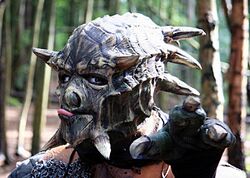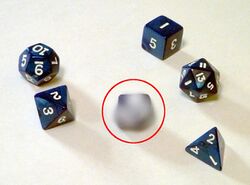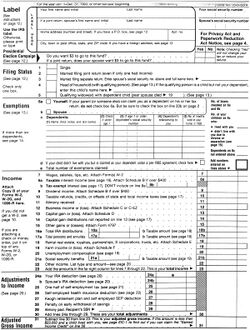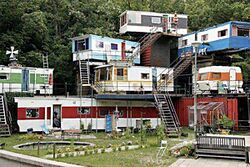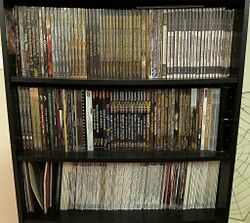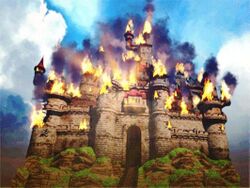Dungeons and Dragons
Dungeons and Dragons, as discussed on this page, is a classic pencil-and-paper table top role playing game. It's sort of like a cross between a war game played on a hex grid, and World of Warcraft.
Errr... no, that's really not right. A better description would be a cross between Cowboys and Indians and a game of craps.
Errr... actually, that's not right either. It's really more like a cross between Sleeping Grump and Battleship.
Errr... actually, that's not really a good description either.
Maybe the best way to describe D&D is that it's like an SCA event where you never need to leave your house, or even get up out of your chair (except to get the occasional fresh bag of Cheetos).
For "modern" gamers, it's worth pointing out one major difference between Dungeons and Dragons and World of Warcraft. Unlike WOW, where you're typically hundreds of miles from the other players, in D&D you're face to face with them, and well within range of an Intolerable Stench spell. Consequently, if you're playing in an interminable D&D game, you do need to shower occasionally.
Origins of the game[edit]
There are two competing theories for where D&D came from. The story most often repeated by gamers and other apologists is that it was invented by two bored teenagers who were trying to improve on the Cowboys and Indians game they'd been playing. They moved the setting from a woods to a cave, added some monsters, and started using dice to resolve the sort of disputes that arose after one player shouted "Bang! Bang! You're dead!" and the other said "No I'm not, I ducked behind a tree!", and voila, D&D was born.
The other theory, which is described in detail on a number of Christian websites, holds that it was Satan Himself who invented the game, and explained it to Gary Gygax in a dream one night.
The major piece of evidence that Satan had something to do with it comes from the game itself. To make it complicated enough to be interesting, the designers didn't just use common dice with six different sides; early versions of the game use six different kinds of dice. In fact, there are only five regular polyhedra. As a result, there are only five possible forms that dice can take. In particular, there is no such thing as a decahedron,[1] yet the game, as originally designed, uses impossible decahedral dice in addition to the five possible figures. This alone is considered more than adequate proof of its Satanic origins.
(Apologists for the game have pointed out that nonstandard geometry doesn't necessarily indicate the presence of Satan. Cthulhu, in particular, is also well known for messing with angles, and could more than account for all the strange dice used in the game.)
The Original Dice System[edit]
The original D&D used a simple system wherein an attacking player would roll several dice, add them up, and compare the result with the "armor class" of the intended victim. If the roll was high enough, it was a hit; otherwise it was a miss.
This wasn't sufficiently precise to represent the subtleties of many situations, however.
ADD[edit]
To remedy the lack of precision (as well as providing a reason for players to replace their original games with new ones), the designers came out with the aptly named ADD.
In the new version of the game, which was called "Advanced Dungeons and Dragons", the system of dice rolls used was so complex and confusing that it caused permanent disorientation among many who played it, giving rise to a whole constellation of problems, referred to by psychologists as "ADD syndrome". (It was only later that ADD came to be the term of choice to describe schoolchildren who found their teachers boring.)
There were also numerous complaints from players that the system was too slow to apply in practice, with the time required for a combat "scene" typically scaling as the square of the number of combatants. In a complex game, this could cause each six second "turn" in a melee to take an hour or more of player time to work out, with players often complaining of wrist pain due to the constant repetitive throwing of dice. This problem was exacerbated by the presence of "monster summoning" spells in the popular "Whales, Krakens, and Sea Gods" extension pack, which could rapidly completely fill a room with small monsters, every one of which would require several dice rolls to determine the outcome of each turn in a melee. There were rumors of D&D games which were never completed, because all participants graduated from college and moved away before the fight scene they were playing out came to a conclusion.
Attempts at Simplification[edit]
After the mixed reception given the too-complex ADD version, the designers went through a number of redesigns in an effort to make the game more playable.
The culmination of this effort has been D&D version 5, with an enormously streamlined "user interface".
In place of the earlier, highly confusing method for determining whether or not an attack succeeds, in V5, all the player needs to do is:
- Roll one d20 (20 sided die) to obtain a base hit value. (This is written "1d20".)
- Divide the player's strength by 3 (rounding down), and roll that many additional d6's (six sided dice) to obtain a strength modifier
- Divide the player's dexterity by 1.5 (rounding up this time), and roll that many additional d5's (five sided dice) to obtain a dexterity modifier
- Add the player's "proficiency bonus" divided by 2 (and rounded up) to the running total so far
- Depending on whether the player has "advantage", "disadvantage" or "confusion", roll one, two, or three additional times, and, depending on the circumstances, use the minimum, maximum, or geometric mean of the rolls in place of the original value
- Determine a goal value by starting with the base difficulty class for the weapon used (see the weapons table), and then adding the target's armor class to that value. Then roll one d8 for the target's dexterity and skill in dodging and add half of that to the original difficulty class value.
- Take the value you obtained in part (4), divide it by 2 and subtract five. Compare that to the value obtained in part (5).
- If the result is larger by at least 2, it's a hit; if smaller by at least 2, it's a miss. Otherwise, roll a d7 and add that to your proficiency in eyesight. Take that new value, and find the geometric mean with it and the target's base speed value averaged with its gross hit point count.
- If the result of that is no larger than $12,345 enter the result on line 53. This is the tax you owe. Otherwise refer to table X.
Future Changes[edit]
With Version 5 of D&D, TSR (which company is now called something else entirely, by the way) has already taken the step of adding numerous nonstandard dice to the set (d2's, d3's, and d7's, to name just a few). In version 5.2, which has a newly redesigned and even simpler combat system, another new innovation is planned: Non-integral dice.
With this new system, many of the rolls used in the old games won't be necessary; you'll just select the (one) die you need from the set and roll it, and be done with it.
So, for instance, if you have an armor class of 17, a dexterity of 5, a strength of 12, proficiency in dodging, a skill level 3 in "blurring", and you've drunk three or more cups of coffee today, then to find out whether a monster with strength 17, dexterity 12, proficiency in slingshot wielding, and skill in rock climbing can hit you with a thrown dagger, you'd just pick a 17.34 sided die out of the box and have the monster roll it, and if it comes up 7.54 or higher, it's a hit.
The "Call" System[edit]
Another change planned for version 5.2 is the optional use of calling in place of dice rolls.
When you target a monster (or another player), instead of rolling dice, you announce what you're doing, and then shout, "I got you!"
As soon as the monster (or the other player) hears you announce what you're doing, they shout, "Nyah nyah ya missed me!"
If you shout "I got you!" first, then it's a hit; otherwise it's a miss.
If you both shout at the same time, then you repeat "I did so!" while the victim repeats "Did not!" until one of you gets tired of this and goes off to use the bathroom or get a drink of water. The last one to leave wins the exchange.
Attempts at Realism[edit]
Early versions of the game didn't just have you say "I want to turn Joe into a frog" and let it go at that. Instead, they provided exact directions for what you would have to do to attempt to turn Joe into a frog. Players had to actually draw diagrams, chant specific words, heat particular elements, and make specific hand gestures in order to "cast spells". All of the diagrams, chants, etc were spelled out in detail in the appendices to the books.
Though never confirmed by the publisher, there have been persistent rumors to the effect that the spell procedures included in the D&D books were actually obtained from practicing witches and warlocks in the town where Gary Gygax lived.[2] The practice of making the game as convincing as possible was continued until some time in the 1980's; editions produced since then have emphasized the table-top dice-rolling aspects of the game rather more and played down the overly realistic aspects which were so prominent in the early versions.
Disasters[edit]
The attempts at realism in the spell casting sections of the manual led to a disastrous incident in a trailer park outside Smackover, Arkansas, in 1983. A young boy was playing D&D by himself, and he read aloud one of the spells included in the "Perversions and Deceptions" extension pack. He successfully evoked a 17th level demon, which ensorcelled him. Under the influence of the demon, the boy tied his own wrists and ankles together, climbed onto the roof of the trailer, and dove off into the family's swimming pool.
Unfortunately for the boy, the family had no swimming pool; he had only believed there was a pool there because the demon told him there was. He landed head first on a rock and he died.[3]
After this incident and several other similar tragedies, the Perversions and Deceptions extension pack was pulled from the market, and later editions of D&D eschewed exact descriptions of the spells, instead just indicating how many and what sort of dice the player should roll to determine if the spell "succeeded".
Spells Used in the Game[edit]
The D&D game is justly famous for the system of magic used in it, with both clerics and wizards casting spells both in combat and in other situations. There are hundreds of spells described in the books. However, the set used by beginning mages is manageably small. What we've listed here is a collection of basic spells which might be used by a low level mage on their first few adventures.
(For those who are new to the D&D dice system, when we say, for instance, "17d12", we mean Roll 17 12-sided dice and add up the values from all of them. So, in an ordinary craps game, each turn would be a 2d6 roll.)
- Intolerable Stench
- When this spell succeeds, it results in uncontrollable retching in all characters that fail a constitution (bad-smells) saving throw
- Inversion
- Causes the targeted monster to turn inside out. When directed against an undead creature, the sight of its decayed innards can result in 3d7 collateral damage in all bystanders who fail a saving throw against gross-out.
- Mice
- 6d8 mice materialize in the room, causing 1d4 damage on all creatures who are less than two feet tall. In addition, any cats within range of the spell become completely distracted chasing the mice, and can't do anything else for the following 7d10 seconds.
- Deafening Belch
- This spell produces the sound of a (very) loud burp, and does 3d8+3 of sonic damage to all within earshot who fail a constitution (disgusting sounds) saving throw. The spell does an additional 1d6 of bonus "ew yuck" damage if the spell caster has eaten at least three cloves of garlic in the last six hours.
- Disgusting Fart
- Produces a 90 decibel wet-fart sound along with the appearance of sufficient methane gas to cause all creatures within 20 feet of the spell caster who fail a constitution (smothering) saving throw against asphyxiation to faint for 2d6 seconds. In addition, if there are any open flames in the room, the fart may ignite (roll against difficulty class 20 modified by the spellcaster's dexterity in fire fighting) resulting in 7d3 damage to the spell caster and 14d2 damage against all nearby creatures, with damage reduced by 1d3 for each 4.3 feet of distance between the spellcaster and the creature out to a maximum radius of 27.2 feet, increased by 1d6 for each meal which included beans the spell caster has eaten within the past 2d7 days.
- Dead Camel
- Causes a dead camel to manifest at a location specified by the spell caster, with a range of 23.2 feet. (What? What good is it? Heavens -- use your imagination! I can think of more uses for a dead camel than would fit on this page (if there only weren't so many uses, I could list them here).)
- Sacrilege
- This spell causes all fundamentalist Christians within 20 feet of the D&D game to become agitated and call for the banning of all RPGs.
- Munchies
- With a likelihood of 2d6 against a difficulty class of 7, causes the dungeonmaster to become extremely hungry and suggest sending out for pizza.
An Actual Game[edit]
A bald discussion of the rules of D&D can never convey the intense drama and pathos of the game, nor the raw excitement it engenders in those playing it. To give a better idea of what D&D is really like, here's an example of a typical Dungeons and Dragons game. This game took about three hours to play out, which is probably about average for a D&D session.
George (who is the "Dungeon master", or DM for short): What characters are you guys playing?
Sam: I'm playing Thudly, my third level fighter.
Harry: I'm playing Beryl. She's a new mage.
Josephine: I'm playing ... uh ... I want to roll up a new one. You guys get started a while, I'll let you know when I'm done rolling. (She starts rolling dice and making notes on a character sheet.)
George (the DM): OK, let's do this. You're walking across a field and approaching a castle. There's a row of doors in the wall in front of you.
Sam: My fighter, Thudly, bashes the door in.
George (the DM): Which door? There's, like, 300 of them.
Sam: Oh crud. That's a lot. (thinks...) He'll hit the one on the left.
George (the DM) (Rolls dice, then announces...): He bruises his shoulder. Nuthin' happenin' on that door, bro.
Sam: OK he bashes in the second door.
George (the DM) (rolls some more dice): Yah same as the first one.
Josephine is still rolling dice for her new character.
Harry: Beryl's hungry. I'm gonna go get some cheetos. (leaves the room)
Twenty minutes go by. Sam -- or, rather, Thudly -- has now failed to bash in 89 of the doors.
Josephine is still rolling dice and filling in stats on her character sheet.
Harry reenters the room. Flips on the television.
George (the DM): Dude, would you mind? We're trying to play D&D here.
Harry: Nuthin' on anyway. (Flips off the TV and picks up a comic book, starts reading.)
Another forty minutes go by. They've now been playing for an hour. Sam's character has failed to bash in 137 of the doors.
Harry (finishes the comic book): Hey Sam, did you try the knob?
Sam: Wait... what?
Harry: My mage, Beryl, walks up to door number 213 and turns the knob.
George (the DM): The door opens.
Sam: Ah crap that is so lame!
Josephine is still rolling dice and making notes on her character sheet.
George (the DM): You all go through the door. You're now in a large room with about 300 doors in the wall behind you. In front of you there's a sphinx. It's coming toward you. What are you gonna do about it?
Josephine: I'm done rolling! I'm Jesus! I'm a cleric.
George (the DM): What?? You can't name your character Jesus!
Josephine: Why not?
George (the DM): There's a rule against it ... right ... um... (Goes to a shelf and gets down two or three D&D rule books)
Josephine: There is not! (She also gets some books from the shelf and starts looking through them.)
For the next 20 minutes George and Josephine leaf through books looking for a rule regarding the name 'Jesus'.
The game has now been going on for about an hour and a half. The players have made it through one door. Harry is reading another comic book. Sam has fallen asleep with his head on the table; he's snoring loudly.
George (the DM): OK, you can name him Jesus.
Josephine: It's not a him it's a her.
George (the DM): A girl named Jesus??
Josephine: Let's not go through that again, OK? Tell us what the sphinx is doing. (Pokes Sam, who wakes up.)
George (the DM): The sphinx is coming toward you ominously. In case you don't know, sphinxes are immune to everything and they have a natural armor class of 300. So what are you going to do about it?
Josephine: Aren't they part lion?
George (the DM): Yeah. Lion, crow, and woman. They're a mash-up.
Josephine: Jesus throws Mice.
George (the DM): You can't throw Mice, that's not a cleric spell!
Josephine: It is so! (For the next ten minutes Josephine and George leaf through rule books, while Harry continues reading and Sam goes back to sleep.)
George (the DM): OK, you can throw Mice. The spell does one point in damage to the sphinx. (Laughs.)
Josephine: But a lion's a cat, right? And the sphinx is kind of a lion, right? So.... Bwahahahaha! There goes your sphinx!
George (the DM): Oh rats. (Rolls dice, and rolls more dice, and then rolls some more dice.) OK the mice ran out of the room in terror and the sphinx ran after them.
Josephine: No more sphinx! Yay!
George (the DM): (Rolls dice, and laughs.) But now a zombie SWAT team just entered the room, with six zombies wearing helmets and body armor. What are you going to do about that?
Harry (setting down the comic book he's been reading): Beryl throws Cardboard!
George (the DM): Dude! You can't throw Cardboard, that's a third level spell!
Harry: Can so! (They both start leafing through rule books. For the next twenty minutes nothing further happens.)
George (the DM) (finally): You don't have enough spell points to throw Cardboard.
Harry: I throw it anyway. It says I can, right here, on page 317 of appendix 5 to the Pump and Dump extension pack.
George (the DM) (looking over Harry's shoulder): OK but you'll take some damage... (rolls dice for a few minutes)
George (the DM): You successfully throw Cardboard but you sprain your wrist throwing such a high level spell. You take 317 points in damage. You're dead.
Harry: Dude! That's not fair!
George (the DM): Don't blame me, blame the dice. And I told you not to do it. And ... (rolls dice) your spell misses the zombies completely.
Harry: Dude! No way! A spell can't miss!
George (the DM): This one did. (Rolls dice) It missed the zombies and hit the wall, which turned a funny brown color. It looks like you turned the castle into cardboard.... But you've still got those zombies to worry about. Brrrraaaaiiiinnsss! (George laughs in what he thinks is an ominous way)
Sam (who just woke up again): Thudly blasts them with his flame thrower.
George (the DM): You can't do that -- this is D&D, not Doom, there aren't any flame throwers!
Sam: Yes there are, they're from the Gadgets and Gringos extension pack.[4] (Sam and George spend the next 15 minutes leafing through rule books and shouting at each other.)
George (the DM): OK OK OK you can use a flame thrower. But (rolls dice) you miss the zombies.
Sam: I missed with a flame thrower? Dude! How is that even possible??
George (the DM): Don't ask me, ask the dice. Let's see what you actually hit with that blast... (rolls dice some more) Oh crap.
Sam: What?
George (the DM): You set the castle on fire. It's made of cardboard and burns like ... like ... uh...
Josephine: Like the Hindenberg?
George (the DM): Yeah, that. (rolls dice) Looks like the whole thing burned down. And you were inside. You're all dead.
Sam: Oh well, too bad. Let's go get pizza.
- ↑ Yes, really. Google 'platonic solid' for more information; Wikipedia no doubt has lots to say about it. If you want something more comprehensible than the sort of opaque gibberish Wikipedia dishes up on its math pages, check out Artin's discussion of finite subgroups of the rotation group in his text, "Algebra", Prentice-Hall, 1991.
- ↑ Seriously, yes, this is true (about the rumors, I mean, not the truth of the rumors, which is less clear). I couldn't make up something this
sillyremarkable if I tried. - ↑ We know this is true because his step sister witnessed the whole thing, and told the police exactly what had happened. Their parents, who were not home at the time, were heartbroken when they received the news.
- ↑ In fact flame throwers were invented by Archimedes about 2500 years ago so they make
perfectat least some sense in a D&D game.
